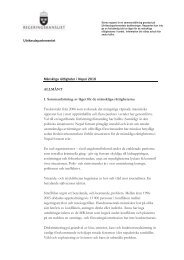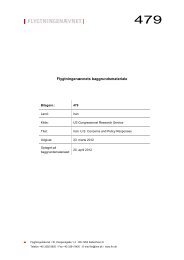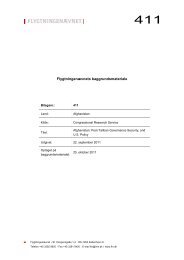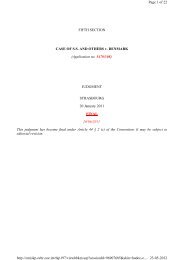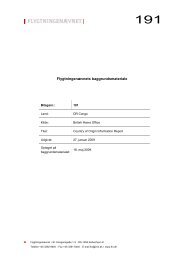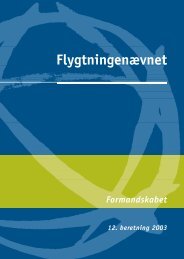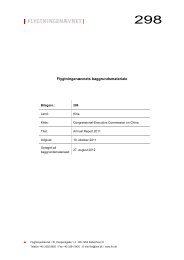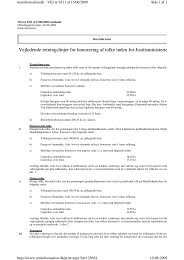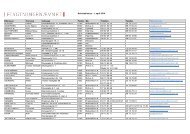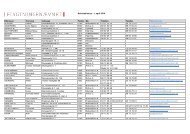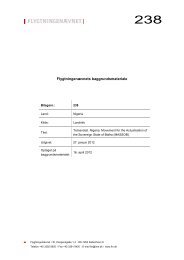Annual Report - National Human Rights Commission
Annual Report - National Human Rights Commission
Annual Report - National Human Rights Commission
Create successful ePaper yourself
Turn your PDF publications into a flip-book with our unique Google optimized e-Paper software.
Annexure 12<br />
○ ○ ○ ○ ○ ○ ○ ○ ○ ○ ○ ○ ○ ○ ○ ○ ○ ○ ○ ○ ○ ○ ○ ○ ○ ○ ○ ○ ○ ○ ○ ○ ○ ○ ○ ○ ○ ○ ○ ○ ○ ○ ○ ○ ○ ○ ○ ○ ○ ○ ○ ○ ○ ○ ○ ○ ○ ○ ○ ○ ○ ○<br />
○<br />
interests of children trafficked or likely to be trafficked, they should be available at places where<br />
vulnerability exists. Their offices need to be linked to Childline and other such helplines so that<br />
assistance is rendered without delay. Instances are aplenty where, for want of CWCs, the rescued<br />
children have been produced before the judicial magistrate and have been deprived of the rights<br />
and privileges due to them under the JJ Act. Therefore, CWCs should be set up in all districts in<br />
India.<br />
Rehabilitative Mechanisms<br />
Rehabilitative measures should be oriented to the best interests of the trafficked victim/survivor.<br />
The NPA of DWCD has made provisions on rehabilitation. However, this study shows that a<br />
uniform policy of rehabilitation will not suffice. Persons who are subjected to commercial sexual<br />
exploitation and are in need of rehabilitation can be categorized into three groups. The first<br />
group includes newly trafficked women and children who are to be rescued without any delay<br />
and should be rehabilitated on priority. The second category includes elderly persons who have<br />
been subjected to exploitation for many years and have been rendered jobless and penniless, and<br />
are mostly sick or infirm. They have no livelihood options before them. The third category<br />
includes other women, mostly middle aged, who are trapped in the brothels because of lack of<br />
appropriate and sustainable rehabilitative mechanisms. The strategy for rehabilitating each of<br />
these categories has to be different and should not only take into account their best interests, but<br />
also have their informed consent.<br />
Rehabilitation should be based on the rights approach rather than the narrow welfare-approach.<br />
It should not be considered as an act of welfare or extending largesse, but should be seen as an<br />
act to protect and ensure human rights. Moreover, decision-making should be participatory,<br />
keeping in view the best interests of the survivor. Livelihood options have to be based on<br />
marketable skills and knowledge. Rehabilitative institutions should have a holistic approach<br />
— with trauma counselling, psychosocial intervention and health care for the victims, as well<br />
as provision for imparting appropriate skills, knowledge and resources for a sustainable<br />
livelihood. Moreover, rehabilitation programmes have to take into consideration the legal<br />
requirements of the criminal cases, if any pending, so that the latter does not become<br />
impediments in proper rehabilitation. It should also be borne in mind that rehabilitative processes<br />
are applicable to both rescued and non-rescued persons. In order to make sure that the victims<br />
who are yet to be rescued do have access to the rehabilitation programmes and processes, it is<br />
essential to provide helplines and other help services, along with adequate public awareness<br />
programmes. Also, rehabilitation programmes have to be made sustainable. Micro-credit and<br />
other facilities should be provided. The local administration should have monitoring mechanisms<br />
to ensure that the rehabilitated person is not retrafficked. The research has brought out the<br />
need for a holistic and integrated rehabilitation scheme for the survivors and victims of<br />
trafficking, with adequate provisions for addressing prevention of trafficking. The government<br />
should also bring out a clear policy on the social security of the survivors, keeping in view the<br />
points stated above.<br />
282<br />
<strong>National</strong> <strong>Human</strong> <strong>Rights</strong> <strong>Commission</strong> <strong>Annual</strong> <strong>Report</strong> - 2004-2005<br />
AR-Chapter-1-19-10-6-06.p65<br />
302<br />
7/17/06, 6:31 PM



